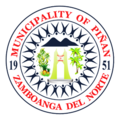Top Qs
Timeline
Chat
Perspective
Piñan
Municipality in Zamboanga del Norte, Philippines From Wikipedia, the free encyclopedia
Remove ads
Piñan, officially the Municipality of Piñan (Cebuano: Lungsod sa Piñan; Subanen: Benwa Piñan; Chavacano: Municipalidad de Piñan; Tagalog: Bayan ng Piñan), is a municipality in the province of Zamboanga del Norte, Philippines. According to the 2020 census, it has a population of 20,221 people.[5]
This article needs additional citations for verification. (January 2023) |
It was formerly known as New Piñan.[6]
Remove ads
Etymology
Piñan came from a Subano term pinyayan which means tabuan (trading place). Before it was established as a formal settlement, this place has been a trading point between natives to the area and ambulant peddlers. In 1903, Captain Finley, a military governor in Zamboanga, established a tabuan in what is now known as Barangay Del Pilar. The tabuan became known as Piñan, and when the municipality was created it was called New Piñan to differentiate it from Piñan.
Another version states that Piñan got its name from the native word piña, a pineapple fruit that grows abundantly in this locality. Vast tracts of pineapple plantations can be seen all over the area. Because of abundance of piña fruits, natives called the place Piñan.
Remove ads
History
Summarize
Perspective
The inhabitants of Piñan were engaged in farming. They cultivated their field by using the “kaingin” system, in which the land was cleared by setting fire to woody plant and bushes, after which holes were bored in the ground with pointed sticks and seeds were planted. They also used wooden plows and harrows drawn by carabaos. Then, Piñan became the source of farm production using their famous horse- or cattle-driven caretelas, and people from neighboring municipalities began coming to Piñan to purchase agricultural products and establish tabuan.[citation needed]
By virtue of Executive Order No. 467 signed by President Elpidio Quirino on August 22, 1951, the municipality of New Piñan, along with Polanco, was organized, separated from Dipolog in the old undivided Zamboanga province. The municipality contains sixteen sitios, organized into barrios, with one with the same name the seat of the government.[7] It was inaugurated through the effort of Serapio J. Datoc, the then-Governor of Zamboanga, and declared as an independent municipality.[8]
The name of the municipality was renamed Piñan through Republic Act No. 2846, enacted on June 19, 1960.[9]
In 1963, the barrios of Dampalan, Labag, Princess La Maya, Marapong, and Sibulan were separated from Piñan to form the new independent municipality of Sergio Osmeña.[10]
Remove ads
Geography
Barangays
Piñan is politically subdivided into 22 barangays. Each barangay consists of puroks while some have sitios.
- Adante
- Bacuyong
- Bagong Silang
- Calican
- Del Pilar
- Desin
- Dilawa
- Dionum
- Lapu-lapu
- Lower Gumay
- Luzvilla
- Poblacion North
- Poblacion South
- Santa Fe
- Segabe
- Sikitan
- Silano
- Teresita
- Tinaytayan
- Ubay (Daan Tipan)
- Upper Gumay
- Villarico
Climate
Demographics
Economy
Poverty incidence of Piñan
10
20
30
40
50
60
2000
48.40
48.40
2003
47.34
47.34
2006
45.80
45.80
2009
55.52
55.52
2012
40.20
40.20
2015
46.05
46.05
2018
46.49
46.49
2021
43.27
43.27
Source: Philippine Statistics Authority[17][18][19][20][21][22][23][24]
References
External links
Wikiwand - on
Seamless Wikipedia browsing. On steroids.
Remove ads





